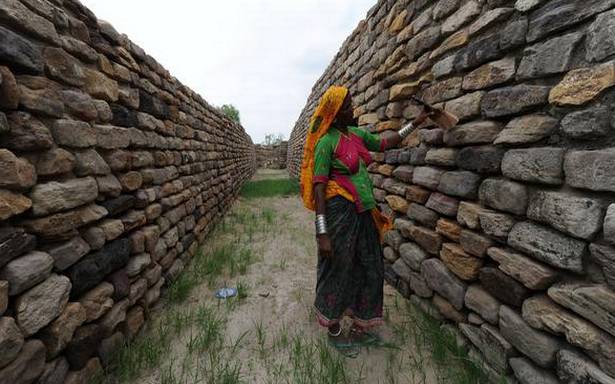The need to boost labour income and consumption expenditure
What are the features of fiscal consolidation and how is it shaping the Budget allocation?
The story so far: The Union Budget for 2022-23 has projected a fiscal deficit of 6.4% of nominal GDP, a narrowing from the 6.9% assumed in the revised estimates for the current fiscal year ending on March 31.
Finance Minister Nirmala Sitharaman said the move was “consistent with the broad path of fiscal consolidation announced” by her last year in order to reach a fiscal deficit level below 4.5% by 2025-26. “While setting the fiscal deficit level in 2022-23, I am conscious of the need to nurture growth, through public investment, to become stronger and sustainable,” she added.
What was the economic context to this year’s Budget formulation?
Though every economic crisis involves sharp reduction in output growth rate, the specificity of the present crisis in India lies in the sharper reduction in labour income as compared to profits. The consequent reduction in income share of labour was associated with a sharp fall in consumption-GDP ratio as well as absolute value of consumption expenditure during the pandemic. While the GDP in 2021-22 is estimated to attain the pre-pandemic level, real consumption expenditure remains to be lower as compared to 2019-20.
The squeeze in labour income and consumption expenditure witnessed during the pandemic was itself preceded by what turned out to be the longest episode of growth slowdown in the Indian economy since the liberalisation period.
The budget 2022 was placed in the midst of these distinct challenges. The first challenge is specific to the pandemic and pertained to the need of undertaking policies that boosts labour income and consumption expenditure. The second challenge pertained to addressing the structural constraints of the Indian economy that restricted growth even during the pre-pandemic period.
How has the Budget fared in this backdrop and what are the key shortcomings?
Continuing with the objective of fiscal consolidation, the Budget falls short of addressing both these challenges.
There are three distinct features of this fiscal consolidation process. Firstly, while share of revenue and non-debt receipts in GDP has remained more or less unchanged, the objective of fiscal consolidation has been sought to be achieved primarily by reducing the expenditure-GDP ratio (see figure 1).
The brunt of this expenditure compression fell on revenue expenditure. Continuing with the fiscal strategy adopted in the last two years since the pandemic, the allocation of capital expenditure as a share of GDP has been marginally increased in 2022-23 as compared to 2021-22. Though additional capital expenditure could be financed either by postponing fiscal consolidation process or by increasing revenue, however, the budget has sought to achieve fiscal consolidation by reducing the allocation for revenue expenditure-GDP ratio.
Secondly, since the bulk of the revenue expenditure comprises of food subsidies and current expenses in social and economic services, reduction in the allocation for revenue expenditure has been associated with fall in several key expenditure that affect the income and livelihood of labour (see figure 2).
For example, allocation for both agriculture and allied activities and rural development registered a sharp decline in nominal absolute terms in 2022-23 as compared to 2021-22. Similarly, in the midst of the ongoing pandemic, total nominal expenditure on medical and public health registered a sharp fall in 2022-23 as compared to 2021-22. Such expenditure compression has been associated with the overall fall in the allocation for total social sector expenditure.
Thirdly, despite sharp increase in profits during the pandemic, the corporate tax-GDP ratio has continued to remain below the 2018-19 level due to tax concessions. The last decade registered a sharp rise in the share of corporate tax concessions in GDP, which reached its peak at 3.9% by 2020-21 (see figure 3). Reflecting the trend in tax concessions, corporate tax-GDP ratio registered a decline particularly since 2018-19 when corporate tax-ratio declined sharply from 3.5% to 2.7%. Despite the objective of fiscal consolidation, the corporate tax ratio continues to remain low and restrict revenue receipts.

What are the implications for development spending?
The objective of fiscal consolidation along with the inability to increase revenue receipts has posed a constraint on development expenditure. With non-development expenditure comprising of interest payments, administrative expenditure and various other components which are typically rigid downward, the brunt of expenditure compression has fallen on development expenditure.
Figure 4 shows the trend in share of centre’s development expenditure in GDP since 2008-09. While the decade of 2010s was characterised by different governments meeting fiscal targets by adjusting their expenditure, it registered a sharp decline in the development expenditure ratio till the advent of the pandemic in 2019-20. Albeit to a limited extent, the fiscal stimulus implemented in the first year of the pandemic brought about a brief recovery in 2020-21. The fiscal consolidation strategy carried out in the last years has once again led the development expenditure ratio to slide downward.
The reduction in the allocation for development expenditure ratio for 2022-23 reflects reduction in the allocation for food subsidies, national rural employment guarantee program, expenditure in agriculture, rural development and social sector.
Why is the Budget’s fiscal consolidation approach a concern from the macro-economic perspective?
The Budget estimates of different expenditure are sensitive to the growth estimates for 2022-23. If the GDP growth rate and revenue growth rate happens to be lower than what is projected, then the actual expenditure can turn out to be even lower than what is projected. Given the fact that the actual GDP growth rate in at least the last four years have been consistently lower than what was initially projected by the Economics Survey, the possibility of actual expenditure falling short of budget numbers cannot be assumed away.
But even if the actual expenditure is close to the budget estimates, the recovery of labour income and consumption expenditure would be largely restricted by the manner in which fiscal consolidation has been carried out. This is because reduction in the allocation for development expenditure would have adverse impact on labour income and consumption expenditure. The positive impact of higher capital expenditure on the recovery process would be largely curtailed by the adverse impact of more than proportionate fall in revenue expenditure.
Given the fiscal consolidation strategy of the Government, the prospect and extent of economic revival at the present remains heavily dependent on external demand. Despite the brief recovery in exports in the last few quarters, the possibility of sustained economic recovery relying exclusively on the export channel appears to be bleak at the present as different countries have already started pursuing fiscal consolidation at the dictate of the IMF. What the Indian economy lacks at the moment is an effective policy instrument that can boost labour income and aggregate demand.
Zico Dasgupta is an Assistant Professor at the School of Arts and Science, Azim Premji University, Bengaluru and Kavya Menon is Research Assistant at Azim Premji University, Bengaluru
Source: Read Full Article


